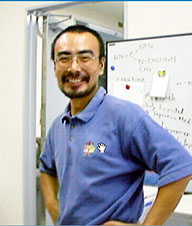
报告时间:2017年5月15日(周一)上午10:00
报告地点:南开大学 蒙民伟楼 201室
报告人: Toshifumi
Takeuchi 教授 (Graduate
School of Engineering, Kobe University)
报告题目:
Molecularly Imprinted Nanomaterials for Sensing and Drug Delivery Systems
摘要: Our
research group is intensively focused on the development of biomimetic/bio-inspired
polymers with affinity adsorption activity, signalling functions, catalytic
activity, and other bio-related functions. We use these polymers in molecular imprinting
(the template-induced formation of specific recognition sites) in order to achieve
molecular recognition in specific binding cavities via these bio-related functions
[1]. So far, we have prepared many MIPs with high affinity, selectivity, and specific
signalling functions for biologically active compounds, including herbicides, endocrine
disruptors, antibiotics, nucleobases, drugs and proteins. Recently, we proposed
the idea of post-imprinting modifications (PIMs), which was inspired by
posttranslational modifications (PTMs) of proteins. Similar to PTMs, PIMs
enhanced the functionality of MIPs in a variety of ways, specifically by
forming cofactor-coupled molecularly imprinted cavities where prosthetic groups
are introduced into these cavities either covalently or non-covalently to
improve binding activity [2-11]. In this presentation, recent advances in
PIM-based MIPs will be discussed in detail. Also I will present novel and quite
unconventional long circulating MIP-based nanogels (MIP-NGs) in the blood
streams capable of acquiring stealth in situ by cloaking themselves with the body's
own dysopsonic proteins [12]. Since nanomaterials have been attracting
attention in the fields of biomedical and life sciences, our challenge will
provide a new class of drug nanocarriers for therapeutic purpose.
References
[1] Takeuchi, T., et al. Chromatography 2014, 35, 139-145 (open access).
[2] Horikawa, R., et al. Angew. Chem. Int. Ed. 2016, 55, 13023.
[3] Kuwahara, A, et al. Angew. Chem. Int. Ed. 2014, 53, 12765.
[4] Sunayama, H., et al. ACS Appl. Mater. Interfaces 2014, 6, 20003.
[5] Sunayama, H., et al. Chem. Commun. 2014, 50, 1347.
[6] Suga, Y. Chem. Commun. 2013 49, 8450.
[7] Taguchi, Y., et al. Langmuir 2012, 28, 7083.
[8] Sunayama, H., et al. Biosens. Bioelectron. 2010, 26, 458
[9]Takeda, K., et al. J. Am. Chem. Soc. 2009, 131, 8833.
[10] Takeuchi, T., et al. Org. Biomol. Chem. 2006, 4, 565.
[11] Yane, T., et al. Org. Biomol. Chem. 2006, 4, 4469.
[12] Takeuchi, T., et al. Angew. Chem. Int. Ed. 2017, in press. (DOI:
10.1002/anie.201700647)